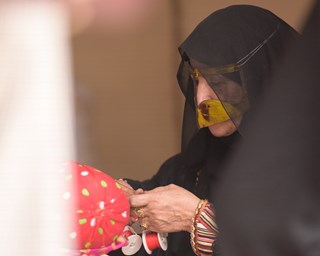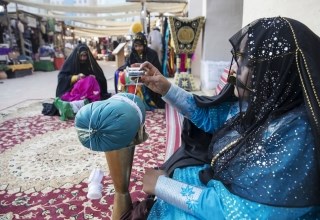The Burga
The burga is one of the most important items of dress for Emirati women as well as one of the most important outward decorative pieces used since ancient time. The burga has accompanied Emirati women for many years affording them a special character, the wearing of a burga signifying their maturity or marital status.
As such, women were obliged to cover their main facial features upon marriage. The reason for this is that the extended family would all live in the same place of residence, from the young to the old, and therefore it was not desirable for a woman to reveal her face, even to her relatives. In this way, the burga was a cover for her modesty.

The burga is a kind of thick cloth that resembles a fine sheet known popularly as "kharjat neel". It is gold in colour that turns black with frequent use. Women in the past would give it this colour, currently imported from India in a ready-made fashion that can be cut and made into a shape close to a square to cover facial features except the eyes.
The burga is secured to the face using a twisted red string known as "shibij". At weddings and on occasions, women use a silver or gold string to decorate the burga.

With the evolution and development of conditions, the burga began to change shape, with many new additions being added such as changes to the type of fabric, design and completing accessories.
Despite such changes, the of wearing the burga has become limited to older ladies, its practise gradually declining through the generations, spurred on by women's university education and employment in various professions and specialisations.

The Making of the Burga
The craft of making burgas was limited to women only. Women in the past would cut the burga from fabric known as "sheal" brought from India in three varieties: Red was the most expensive and was used by rich women, yellow was the poorest quality, associated with married women, and green, which is most commonly used today.
The "sheal" fabric would be lined with a protective layer to avoid the coloured fabric from staining the face. However in olden times this layer was not used as the red cloth would give the cheeks an attractive colour. It was therefore considered shameful for a girl or woman to remove the burga so that her face would not appear stained. Currently however a protective layer is sewn onto the fabric of the burga fixed by a centre connector and ties at the upper sides.
From the front the burga consists of a straight line that cuts from the top, intersected by a dividing line into two equal parts, the front line often braided or decorated with stars or other accessories. The eye holes in the burga curve downwards, stretching from the front to the end of the eye opening on both sides.
The connecting line of the burga consists of a stick made of palm or newspaper, starting from the middle of the forehead to the end of the burga down the middle. The part of the burga covering the face can be a large or small depending on the woman's request. Finally the "shabouj" is the string that fixes together the two sides of the burga from right and left, often made of goat hair or wool, also made now from plastic or coloured yarn.
Goat hair is the best material for fixing the burga to the head, however it does not give any decorative character such as modern yarn that is specific to occasions and weddings.
Burga styles and models differ from one place to another, the eye opening differing according to where the woman is from or the occasion.
The burga with a large opening, known as the "aynawi" burga is used for occasions and decoration more than for the purpose of modesty, often used by women from the western regions of the Emirates. Currently the most common type of burga used by women in the eastern region is more modest and covers more facial features, being larger in size and less glamorous than other types.